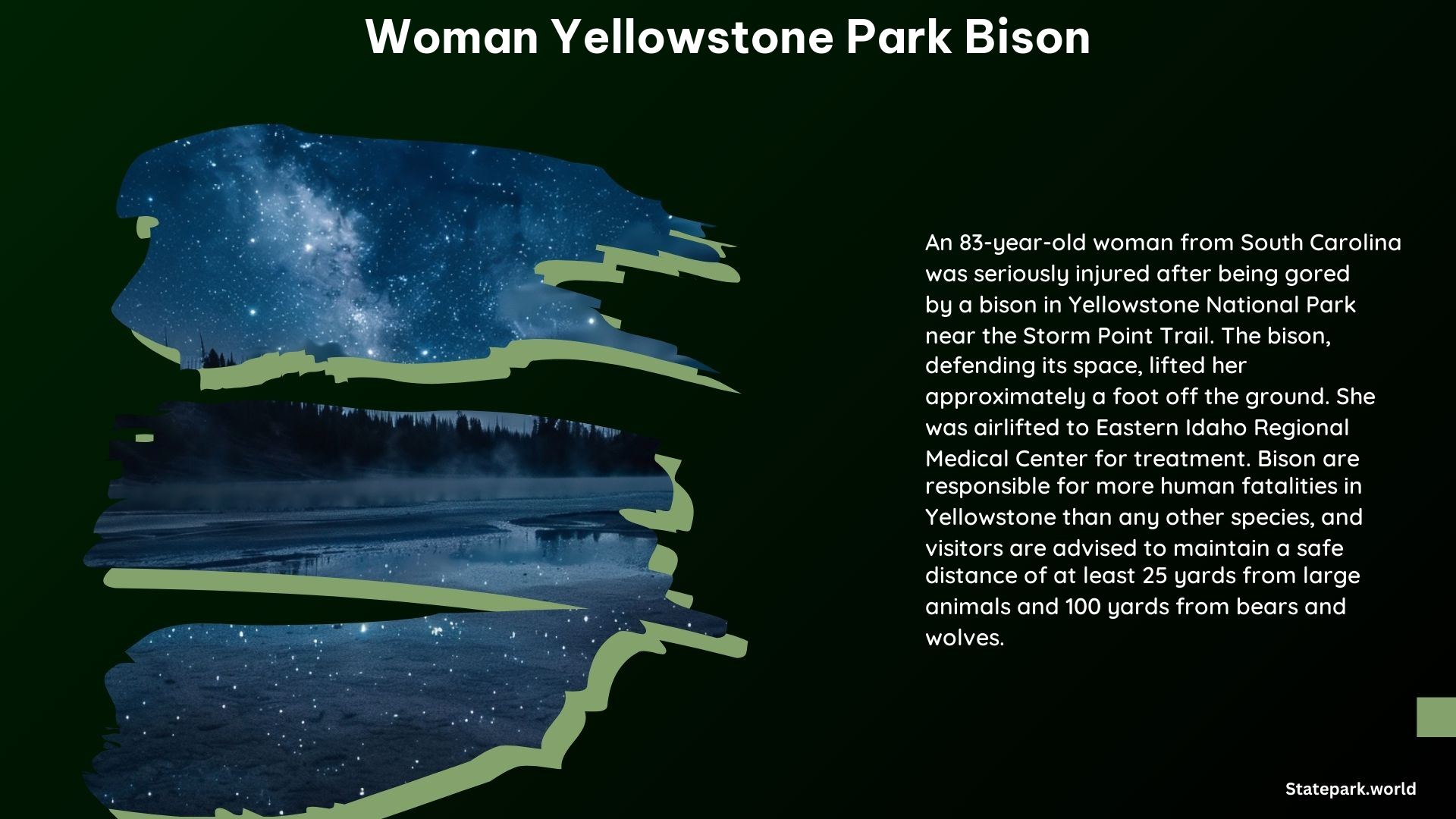On June 1, 2024, an 83-year-old woman from Greenville, South Carolina, was seriously injured when she was gored by a bison near the Storm Point Trail at Yellowstone Lake. The bison, defending its space, lifted the woman about a foot off the ground with its horns, causing significant injuries. She was transported to the Lake Medical Clinic and then airlifted to Eastern Idaho Regional Medical Center for further treatment.
What Happened to the Woman Who Was Gored by a Bison in Yellowstone National Park?
The incident occurred on June 1, 2024, near the Storm Point Trail at Yellowstone Lake. The 83-year-old woman from Greenville, South Carolina, was walking on the trail when she encountered a bison. The bison, likely feeling threatened or defending its territory, charged at the woman and lifted her about a foot off the ground with its horns.
The woman sustained serious injuries from the attack. She was immediately transported to the Lake Medical Clinic within Yellowstone National Park for initial treatment. Due to the severity of her injuries, she was then airlifted to the Eastern Idaho Regional Medical Center for further medical care.
The details of the woman’s specific injuries have not been publicly disclosed, but it is clear that the encounter with the bison resulted in significant harm. Bison are known to be unpredictable and can be dangerous when they feel threatened, especially during mating season or when they have young calves nearby.
How Close Should Visitors Stay from Bison and Other Large Animals in Yellowstone National Park?

Yellowstone National Park is home to a diverse array of wildlife, including bison, elk, bighorn sheep, deer, moose, and bears. It is crucial for visitors to maintain a safe distance from these large animals to prevent potentially dangerous encounters.
According to the National Park Service, visitors should maintain the following distances from various animals in Yellowstone:
| Animal | Minimum Distance |
|---|---|
| Bison, elk, bighorn sheep, deer, moose, coyotes | 25 yards (23 m) |
| Bears and wolves | 100 yards (91 m) |
It is important to note that these distances should be increased during mating season (mid-July to mid-August) for bison, as they can be more aggressive and unpredictable during this time.
Visitors should also be aware of their surroundings and the behavior of the animals. If an animal appears agitated or is displaying signs of aggression, it is best to slowly back away and give the animal more space. Approaching or getting too close to these large animals can provoke a defensive or aggressive response, putting the visitor at risk of injury.
Bison Population and Historical Incidents in Yellowstone National Park
Bison are a iconic and integral part of the Yellowstone ecosystem. As of August 2023, there are approximately 420,000 bison in commercial herds and 20,500 in conservation herds within the United States.
While encounters with bison in Yellowstone National Park are relatively common, serious incidents resulting in injuries are not as frequent. However, there have been several recent incidents of bison-related injuries in the park:
- In April 2024, a 47-year-old woman was injured after being gored by a bison near the Norris Geyser Basin.
- In June 2022, a 71-year-old tourist was attacked and injured by a bison near the Fairy Falls trailhead.
These incidents serve as a reminder that visitors must exercise caution and maintain a safe distance from these large and unpredictable animals, even in a national park setting. Respecting the wildlife and following the park’s safety guidelines can help prevent such unfortunate encounters.
Conclusion
The incident involving the 83-year-old woman from Greenville, South Carolina, who was gored by a bison in Yellowstone National Park, is a sobering reminder of the importance of maintaining a safe distance from these large animals. While Yellowstone is home to a diverse array of wildlife, it is crucial for visitors to follow the park’s safety guidelines and be aware of their surroundings to prevent potentially dangerous encounters.
By understanding the appropriate distances to maintain from bison, elk, bears, and other animals, and being vigilant during mating season, visitors can enjoy the beauty and wonder of Yellowstone National Park while prioritizing their own safety and the well-being of the park’s wildlife.
As we continue to explore and appreciate the natural wonders of Yellowstone, it is essential that we do so with respect, caution, and a deep appreciation for the delicate balance of the ecosystem. By following the park’s guidelines and respecting the boundaries of the wildlife, we can ensure that Yellowstone remains a safe and enjoyable destination for generations to come.
References:
- https://www.cbsnews.com/news/bison-gores-woman-yellowstone-national-park-2024/
- https://www.nps.gov/yell/learn/news/230717.htm
- https://www.nps.gov/yell/learn/news/240603.htm
- https://www.npr.org/2024/06/05/g-s1-2891/83-year-old-bison-yellowstone-park
- https://abcnews.go.com/US/83-year-woman-injured-after-gored-bison-yellowstone/story?id=110797209
